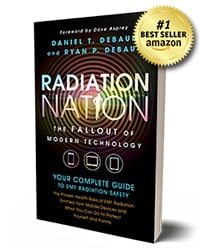Your cart is currently empty!

EMF Radiation Comparisons in Cell Phones, Laptops, Tablets
Last Updated on October 17, 2023

In recent years, scientific evidence has identified that the frequencies of EMF radiation coming from our cell phones, tablets, and laptops may not be enough to cause permanent thermal damage to our bodies, or instantly ionize our cells, like Gamma rays can, but it can have adverse biological effects on the body.
These are detectable at the cellular level, but can have sweeping effects on different systems and organs!
Which mobile device is the safest??
Are any safe?
While there are differences between the different mobile devices and the radiation they emit, at the end of the day any level of radiation can be harmful if it is close or in direct contact with your body for an extended amount of time.
Cell Phone Radiation
Cell phones emit ELF, or Extremely Low Frequencies, from their internal electronic circuitry. As a small device, they have relatively low ELF output, compared to laptops and tablets.
They also emit RF, or Radio Frequencies, when connecting to a cellular network. Smart phones take it a step above, since they also include WiFi and Bluetooth transmitters that emit RF radiation.
A key difference setting cell phones apart from tablets and laptops is that they operate on a cellular network. With other mobile devices, cellular connections are not used as often. To connect to a cell tower, a cell phone has to send a signal sometimes miles and miles away (it can reach 45 miles in some instances). The power level of this signal increases the farther away you are from a tower, which increases the emissions from the device. Federal limits state your phone cannot go over a SAR level of 1.6 watts per kilogram (although this can vary up to 20%).
In comparison, WiFi and Bluetooth are used by many electronics, and don’t vary as much device to device. WiFi signals can travel hundreds of feet, and Bluetooth signals can’t travel more than 90 feet. This means you need less power to connect, but that doesn’t make you more safe. WiFi routers have different output levels, but can go up to 6 watts per kilogram, making WiFi more dangerous than cellular. WiFi will not modulate power levels as distance increases, unlike a cellular connection.
All these levels can cause harm to the body after an extended period of exposure, which brings us to our second key difference.
Cell phones are with us all day long. Usually in a pocket, in our hand, in our lap, or against our head. Even at night, they rest under your pillow or on your nightstand. This length of exposure, and proximity to the radiating source, puts us the most at risk. Other devices might just be used for small portions of the day, or farther away from our bodies.
In a June 5, 2013 article, Act Against Conventional Pollution, Cell Tower Radiation, Experts Exhort, The Times of India reports cell phone radiation and tower emissions as pollutants no different from other environmental pollutants of our air, water and noise. Pollutants capable of creating adverse health effects such as skin rashes, hearing problems, sleeplessness, migraines, fatigue, lack of concentration, fearfulness and skin dehydration. They report that “International studies show that mobile tower radiation may not only be capable of causing cancer, but also neurotic disorders like Parkinson’s and Alzheimer’s.”
Internationally regarded epidemiologist and Environmental Health Trust founder Dr. Devra Davis points out that the cell phone industry uses strategies it has learned from the tobacco industry to deceive the public about cell phone radiation. She says, “The average studies of cell phones and brain cancer have studied people who have used cell phones for five years or less. Sometimes eight years. Every study that has actually examined people who have used phones for 10 years or more, and is well designed, finds a 50 percent to an 800 percent increased risk. So that is why the Israelis, the Finnish, the French governments have all issued warnings.”
According to Davis, studies conducted by the Cleveland Clinic and other worldwide organizations have also found clear evidence linking cell phone radiation to male sperm damage. In the Cleveland lab, the cell phone exposed sperm died three times faster with three times more damage to their mitochondrial DNA.
Laptop And Tablet WiFi Radiation

Laptops are the biggest mobile device, and as such, use the most power. This means ELF exposure is a higher the power level of cell phones, as is the heat radiation that is a byproduct of EMF. However, since most laptops lack a cellular data connection, that eliminates a source of RF radiation.
Laptops use WiFi and Bluetooth connections, but since they are using more power than a cell phone, more data is riding on the WiFi carrier signal, giving off greater emissions. However, the WiFi signal strength remains the same, up to 6 watts per kilogram.
Tablets are smaller than computers, and so emit less radiation.
In March of 2013, The American Academy of Environmental Medicine (AAEM) sent a letter to the Los Angeles Unified School District warning about dangers of wireless radiation. They believe there has been an increase of patients seeking help for today’s WiFi radiating devices such as laptops and tablets and recommend minimizing radiation exposure when using these devices.
AAEM says there is “consistent emerging science showing people, especially children are affected by the increasing exposure to wireless radiation.”
Since Laptops and tablets often sit directly on the lap and away from your head, there is not as much of a risk for developing brain cancer or neurological effects as there is with cell phones. However, there is still an important effect on cells, which can still lead to adverse health effects throughout your body. In particular, fertility can be directly affected.
A November 2011 paper appeared in the Journal of the American Society for Reproductive Medicine ‐ Fertility and Sterility that demonstrated a significant decrease in sperm progressive motility and a significantly higher proportion of sperm with DNA fragmentation when samples were incubated for 4 hours under the laptop.
Along with damage to sperm motility and DNA, the AAEM lists health effects from exposures to WiFi by stating “learning disabilities, altered immune responses, and headaches, clearly exist and are well documented in the scientific literature.” Finally, the AAEM strongly discourages school systems from installing WiFi. They point out that the human health effects of WiFi are still unknown and “this uncertainty is not a reason to subject a generation of children to such extreme exposure.” A cautious approach of wired connections in the schools is suggested to avert potential public health disasters.
Merging EMF Radiation Concerns

The medical and scientific community are now starting to blend their knowledge of the health risks from cell phone and laptop RF emissions. Back in June of 2013 a panel of U.S. experts met to discuss the effects of EMF radiation.
The event, Children’s Health Expert Panel – “Cell Phones & WiFi – Are Children, Fetuses and Fertility at Risk?“, examined the impact to children from radiation exposure emitted by cell phones, wireless routers, wireless baby monitors, portable phones, laptops and other RF-producing devices.
They also explored the effect of RF electromagnetic radiation on fertility and reproduction, long-term consequences from exposure in utero, and the irreversible impacts on DNA.
Distinguished panelists included: Dr. Devra Davis, PhD, MPH, founder of The Environmental Health Trust and the first Center for Environmental Oncology at the University of Pittsburgh Cancer Institute: Hugh Taylor, MD, Professor and Chairman of the Department of Obstetrics, Gynecology & Reproductive Sciences at Yale University; David Carpenter, MD, Professor of Environmental Health Sciences and Director of the Institute for Health and Environment, University of Albany School of Public Health, and several other industry leaders.
Conclusion
RF emissions come from WiFi access points, routers, laptops, tablets, and cell phones. In terms of which is the safest, they could all be potentially dangerous. The most important factors that deem any one of these devices more dangerous than the other is the time you are using it and your proximity to the device. ELF and RF levels might be different depending on your device of choice, but any level can be harmful with chronic exposure.
The impact of emission exposure is controversial, because widespread use of these devices only began in the last 15-20 years. With the technology so new, any research conducted so far has given mixed results, making long-term health effects of exposure somewhat unclear. It seems though, recent EMF emission research is starting to substantiate the real risks of radiation from all mobile devices.
We are using EMF-radiating devices in our laps and near our heads for long periods of time and should thoroughly consider the dangers. To be safe, we should try and minimize exposure when possible, maintain distances and reduce time when using these devices, and when close to your body, consider using an radiation shield.
Related Posts
None found



























